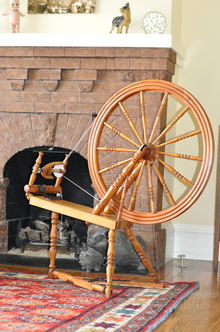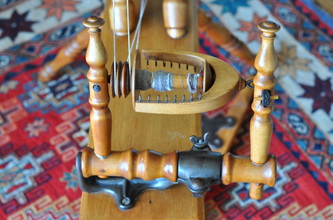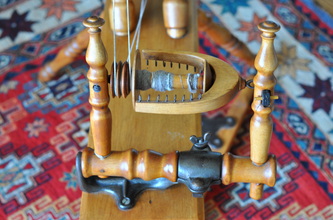|
So... there's a thing about things. There's something special and magical and interesting (to me, anyway,) about how "things" exist for the whole time that we are alive, and for decades (or centuries) before, and then, one day, they arrive in your life. I also think about the path that we as individuals take that lead us to each other. Yes, I'm a bit nuts. OK, back to the new wheel. (Didn't I mention?! I have a new wheel!) OK... it's old, but it's new to me!  Since I saw my very first Canadian Production Wheel in Albany, NY in 2012, I have wanted one. I blame you, Celeste, for showing up to knit night full of excitement about your new wheel. Yes, I know. I said I was only going to have one wheel... but a guy can change his mind, right? (Actually, I've always wanted an old wheel, and this type is beautiful, simple in design, and a real workhorse!) My other wheel, a Schacht Sidekick, is different. It's portable, modern, and has other features like additional whorls that make it different. Different is good, right? THIS wheel... my new (old) CPW, has a 30" wheel, single treadle, and only one bobbin and whorl. It has a higher ratio and is a faster spin all the way around. Once the bobbin is full, I'm told that folks generally wind the single onto a different bobbin to preserve the leather pieces that hold the flyer assembly. My wheel feels like new in that area, so I'm sort of hoping to find more bobbins (or have them made) so that I can switch them out. I have a feeling that if I can just switch out bobbins when they're full, it'll make for more spinning. I LOVE my wheel. I said that one day I would own a CPW. One day. Thank you to my friend who answered, and for those who have guided and supported me in my crazy decision to buy another wheel. I now own one. And it's beautiful. SO beautiful. What do I know about these wheels? Most were made in Quebec, Canada in the late 1800s - early 1900s, and many can be found for a reasonable price. They have one speed on the whorl, and either the beautiful cast iron pedal like mine, two metal strips, or a wooden pedal, and usually only one bobbin. I was lucky to get mine from a California seller who was looking to reduce her inventory. She was kind enough to drive it up to San Francisco (hooray for easy delivery!) and today it lives as part of my studio collection. I was able to sit down yesterday for a few minutes and try spinning on her, and I was able to make a single pretty easily. The only immediate thing I believe I need to do (besides remembering to always oil oil oil) is to make a longer drive band so that the mother-of-all can be moved back to about the 11:00 position. I hear that will make a difference in how she spins. I'm still working on the treadling. This is a single treadle which makes it feel different than the new double-treadle of my sidekick. In time, me and this old wheel will get to know each other, and once I can get it to spin with little effort, the next step will be working on my long draw technique. With time and practice I'll have the ability to produce yarn in production level quantities. For now, though, I'm really really happy even having my new wheel in sight. I find myself putting myself to sleep at night wondering about who worked on it, and where it's been in its century of existing. It was probably around at the time of the Titanic sinking, and might have even been around as early as the big earthquake in San Francisco in 1906. Now it lives with me in my home on the hill. As I learn more, I'll be happy to narrow down its date of creation. And, as required, here's the "selfie" portrait of me and my CPW: Do you know about this wheel? I'd love to hear! Post in the comments to share your knowledge! Thanks
|
Archives
July 2023
Categories
All
|
ExploreFor Fun
|
Support |
Connect |
© 2006-2023 Kyle William. All Rights Reserved.












 RSS Feed
RSS Feed
